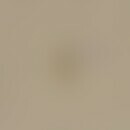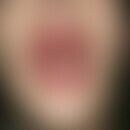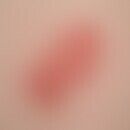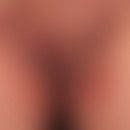Synonym(s)
DefinitionThis section has been translated automatically.
ClassificationThis section has been translated automatically.
You might also be interested in
Occurrence/EpidemiologyThis section has been translated automatically.
Anal eczema is considered to be the most common proctologic disease. Data on prevalence is vague. There is no specific coding in the ICD.
EtiopathogenesisThis section has been translated automatically.
The main pathophysiological correlate of anal eczema is a dysfunctional epidermal barrier. The disturbed barrier function can be constitutive or caused by exogenous factors. The damaged epidermal barrier itself predisposes to increased sensitivity to irritants, allergies and infectious pathogens.
The anatomical peculiarity of the anal region favors the development of eczema (secretion of the eccrine or apocrine sweat glands - induction of a moist microclimate/moist chamber), whereby the hairiness can cause additional moisture retention. This situation is intensified with increased transanal or perianal secretion in the context of various proctologic diseases.
The consequence: behavioral changes (intensified anal hygiene, scratching effects).
ManifestationThis section has been translated automatically.
Anal eczema can occur at any age and in any gender.
LocalizationThis section has been translated automatically.
DiagnosisThis section has been translated automatically.
When investigating the cause of allergic contact eczema, it is necessary to look for possible allergens in foundations, preservatives or active ingredients in topical products (ointments, suppositories).
Intimate sprays, powders, condoms, dyed toilet paper, detergents and disinfectants can also be the cause of contact sensitization (see below anal eczema contact allergic). It is important to exclude hemorrhoidal disease, inverse psoriasis and atopic diathesis (see differential diagnosis below).
Differential diagnosisThis section has been translated automatically.
- Frequently:
- Psoriasis inversa or psoriasis intertriginosa (sharply defined, frequently itchy, mostly macerated, red, fully filled 5.0 - 10.0 cm large or larger, patches or very flat, sometimes weeping plaques; no prominent marginal accentuation (DD tinea intertriginosa); no foci of satellites (as in intertriginous candidiasis), no central healing pattern.
- The typical psoriatic scaling is always absent.
- Streptococcal dermatitis, perianal (fever possible, usually non- or slightly infiltrated, well-defined, perianal erythema of 0.5-3.0 cm Ø or red, weeping papules that occasionally secrete pus. Severe, persistent itching and defecation pain. Bloody stool deposits in 30-40% of cases; smear test).
- Perianal candidiasis (erosive oozing, whitish marginal coatings, satellite foci, microscopy and culture)
- Tinea perianalis (rarely limited to the perianal region, marginal accentuation, central healing tendencies, microscopy, culture)
- Erythrasma (Wood light, red fluorescence)
- Lichen sclerosus et atrophicus (hardened bulging whitish anal folds, erosions, histology is diagnostic)
- Lichen planus (rarely isolated in the perianal region; look for typical distribution pattern)
- Lichen simplex chronicus (rare, infiltrated, definable plaques)
- Oxyuriasis (oxyuriasis often visible, scratching effects, itching especially at night, microscopic evidence of worm eggs)
- Rarely:
- Pemphigus chronicus benignus familiaris (clinic and histology)
- Pemphigus vegetans (clinic and histology)
- Acrodermatitis enteropathica (rare, picture of irritative weeping anal eczema due to recurrent diarrhea, reduced general condition with growth disorders, recurrent superinfections/Candida albicans)
- Dyskeratosis follicularis (Darier's disease)
- Condylomata acuminata (clinic)
- Perianal syphilis (Condylomata lata, sweet odor, weeping, serology)
- Neoplasia
- Bowen, M. (clinic and histology)
- Paget's disease, extramammary (clinic and histology)
- Perianal squamous cell carcinoma, anal verge and anal canal carcinoma (clinic, rough plaques or nodules, histology)
General therapyThis section has been translated automatically.
Optimized anal hygiene: treatment of the underlying or concomitant proctological disease. Avoidance of irritants and potential allergens. Soap-free cleaning of the anus with clear water. Application of local anti-inflammatory agents based on zinc-containing lotions and pastes.
In the case of weeping anal eczema, short-term use of ointments containing hydrocortisone(low-medium potency topical corticosteroids are recommended). A steroid-free alternative would be Lotio alba.
Calcineurin inhibitors: After induction therapy with topical corticosteroids, maintenance therapy with topical calcineurin inhibitors (pimecrolimus, tacrolimus) can be continued as proactive intermittent maintenance therapy.
Antimycotics, antibiotics and antiseptics:
- Topical antimycotics in suitable bases can be used liberally in cases of mycotic overgrowth, depending on the pathogen spectrum. Combinations (antimycotics + corticosteroids) can be used in the short term depending on the findings!
- The use of topical antibiotics (neomycin, mucipirocin, bacitracin, erythromycin) should be limited due to the general sensitization potential.
- If necessary, sitz baths with synthetic tanning agents (e.g. Tannosynt and Tannolact) or also with disinfectants (e.g. potassium permanganate: dissolve a few crystals in lukewarm water to produce a strong pink solution).
Diet/life habitsThis section has been translated automatically.
Dietary advice is to avoid alcohol and spicy foods.
Soap washes should be avoided.
The perianal area can be cleaned with clear water (preferably using a bidet - if a bidet is not available, a good option would be the HappyPo Easy-Bidet (mobile hand-bidet shower) or with vegetable oils (e.g. olive oil) applied with soft paper towels.
LiteratureThis section has been translated automatically.
- Proske S et al (2004) Anal eczema and its benign simulators. Dermatologist 55: 259-264
- Rajalakshmi R et al. (2011) Lichen simplex chronicus of anogenital region: a clinico-etiological study. Indian J Dermatol Venereol Leprol 77:28-36
- Weyandt G et al. (2020) German S1 guidelines for the diagnosis and treatment of perianal dermatitis (anal eczema). J Dtsch Dermatol Ges 18: 648-657.
- Weisshaar E (2015) Genitoanal pruritus. Dermatologist 66:53-59
Incoming links (11)
Acuminate condyloma; Anal eczema contact allergic; Anal fissure; Analpruritus; Analpruritus; Atopic anal dermatitis; Bile acid loss syndrome; Haemorrhoidal diseases; Intertriginous psoriasis; Marisks; ... Show allOutgoing links (24)
Acrodermatitis enteropathica; Anal dermatitis cumulative toxic; Anal eczema contact allergic; Analpruritus; Atopic anal dermatitis; Bowen's disease; Calcineurin inhibitors; Chronic mucocutaneous candidiasis; Condylomata lata; Dyskeratosis follicularis; ... Show allDisclaimer
Please ask your physician for a reliable diagnosis. This website is only meant as a reference.








